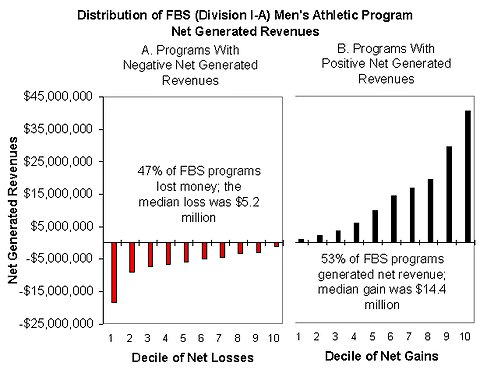
Judith Scott-Clayton is an assistant professor at Teachers College, Columbia University.
The past year has been a busy one for big-time college sports scandals, and for public discussion around how best to tame the beast that “ate college life,” as Laura Pappano put it in a recent article. From recruiting violations and the Jerry Sandusky sex abuse scandal, to the exploitation of student athletes and adverse effects on nonathlete student grades, the barrage of media coverage has thoroughly documented the social costs of big-time college sports.
So why are universities in this business at all?
Today’s Economist
Perspectives from expert contributors.
The seemingly obvious answer — that colleges engage in big-time sports because the money is too good to resist — is only weakly supported by annual revenue and expense data collected by the National Collegiate Athletic Association. While there can be quite a bit of arbitrariness in the accounting underlying these reports, it seems clear that at least some institutions are making money: among the 120 colleges in the Football Bowl Subdivision (F.B.S., formerly called Division I-A), about 25 percent generated $14.4 million or more in net revenues annually from their men’s athletic programs.
But this is hardly the norm. In any given year, only about half of these “big time” men’s programs turn a profit (see chart below). The median men’s program generated net revenue of just $1.1 million in 2009-10, and lost money in three of the six previous years. In the context of overall university budgets — a typical university with 12,000 students spends over $440 million annually — this would hardly seem to be an irresistible amount of money.
 Source: NCAA Division I Intercollegiate Athletics Program Report
Source: NCAA Division I Intercollegiate Athletics Program Report
It is also worth noting that the net revenue figures for athletic departments over all, which include women’s sports and reduce the potential for massaging the allocation of general expenses across programs, look considerably worse, as do the numbers for men’s programs outside the F.B.S.
Still, the obvious answer may be right, but for a less obvious reason: as Charles Clotfelter, a Duke University economist, argues in a recent book, big-time sports are an important mechanism by which universities build both popular and political support. And this isn’t just about bragging rights. Because a vast majority of F.B.S. colleges are public institutions, relying on state and local government appropriations for a quarter or more of their total revenue, popular support (or a lack thereof) can have critical financial implications.
Nor is such support something universities can take for granted. National opinion polls by Public Agenda and the Lumina Foundation/Gallup have identified increasingly negative views of higher education in recent years. And big-time sports programs are disproportionately situated in politically conservative locations that might otherwise be less inclined to support public spending on higher education.
An emerging body of economic research provides both quantitative and qualitative support for Professor Clotfelter’s hypothesis. First, big-time sports are clearly a major source of “free advertising” in the form of press coverage: an analysis by economists at Northwestern University and Mathematica Policy Research found that athletics account for more than half of newspaper articles about public universities. Professor Clotfelter’s own analysis suggests coverage is even more skewed: for universities with big-time sports programs, 87 percent of articles in The New York Times in 2007 were about athletics.
Second, a study by the economists Devin and Jaren Pope indicates that successful big-time football and basketball programs help institutions improve both the quantity and quality of student enrollments — which are both a source of revenue and a reflection of broader public perceptions. For example, the authors estimate that winning the national championship in football generates a 10 percent increase in enrollments the following year.
Third, big-time sports universities clearly leverage their programs to curry favor with powerful people — for example, by giving away free or discounted football tickets to state legislators. Professor Clotfelter analyzed lists of V.I.P. guests who sat in the presidents’ boxes at football games for eight universities and found that government officials made up 10 to 20 percent of these guest lists; university advisory board members and influential people from business and professional circles made up roughly 40 percent.
Finally, there appears to be a significant positive relationship between big-time sports programs and state university funding. Using panel data on state appropriations at hundreds of public institutions between 1976 and 1996, a study by the economist Brad Humphreys estimates that institutions that joined Division I-A gained $6 million in appropriations on average, compared to institutions with no change in division status.
Thus, the available evidence suggests that big-time sports can in fact generate big-time support for their institutions, far beyond what a narrow accounting of revenues and expenses might imply. But the centrality of sports is not without risk. After a year like 2011 — when big-time programs were themselves swallowed up by even bigger scandals — Professor Clotfelter’s hypothesis suggests that institutions have far more to lose than initially meets the eye.
Article source: http://feeds.nytimes.com/click.phdo?i=1f5678acdfe169bb97f9113ecea6229d
Speak Your Mind
You must be logged in to post a comment.